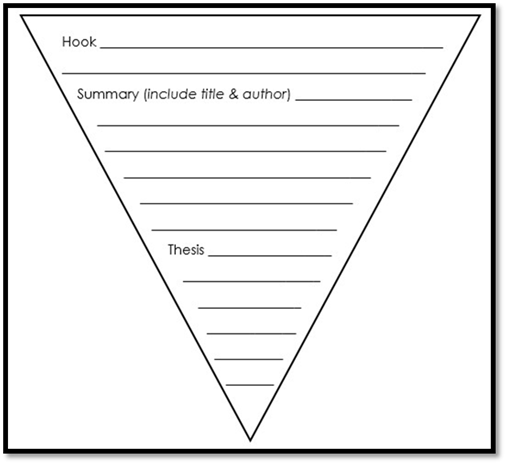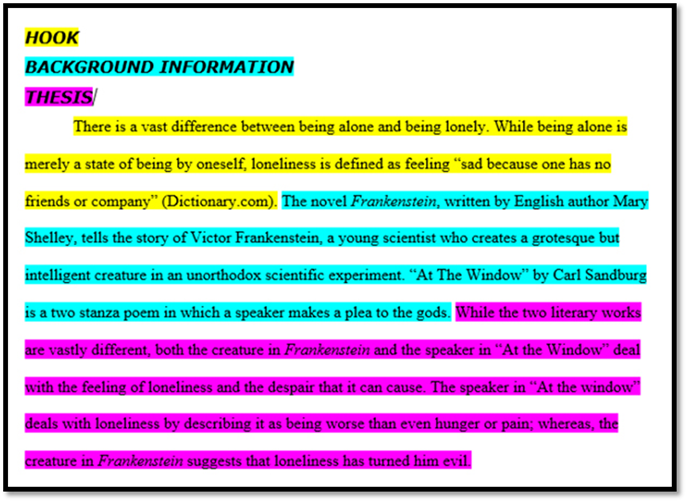Introduction
Unit Overview
In
this unit, you will develop the introduction for your
Literary Analysis essay.
Click here to download
notes for this unit.
Over the next few units, we will construct a
Literary Analysis essay based on the following prompt.
·
Read and take notes on two poems about Helen of Troy—"
To Helen" by Edgar Allan Poe and "Helen" by H. D. (Hilda
Doolittle).
·
Construct a multi-paragraph response in which you analyze
how the subject of "Helen" is treated differently across the two
texts.
Before we begin, you must read the following
two poems:
“To Helen" by Edgar Allan Poe "Helen" by H. D.
Remember the outline of the previous unit…
|
Literary Analysis
Essay: Outline |
|
1. Introduction a. Hook b. Background Information c. Thesis (Central Idea) |
|
2. Body Paragraph 1 a. Topic Sentence for Text 1 b. Textual Evidence
i. Explanation c. Textual Evidence
i. Explanation d. Textual Evidence
i. Explanation e. Wrap-Up Topic 1 |
|
3. Body Paragraph 2 a. Topic Sentence for Text 2 b. Textual Evidence
i. Explanation c. Textual Evidence
i. Explanation d. Textual Evidence
i. Explanation e. Wrap-Up Topic 2 |
|
4. Conclusion a. Restate the thesis in a different way
(central idea) b. Why does it matter? c. Final Thoughts |
We will work towards building that outline
gradually throughout the following units.
What is an
Introduction?
An introduction is the
opening of an essay or speech, which typically identifies the topic, arouses
interest, and prepares the audience for the development of the thesis. It can
also be called an opening, a lead, or an introductory paragraph.
The introduction will contain the following
three things:
1. Hook
2. Background information
3. Thesis
Hook
A hook is a statement
meant to grab the reader's attention.
In a literary analysis essay, a hook is an opening
sentence or paragraph that grabs the reader's attention and draws them into the
essay. The purpose of the hook is to create interest and intrigue, to make the
reader want to keep reading and to set the stage for the rest of the essay.
A hook can take many forms, depending on the
style and tone of the essay, but it should always be relevant to the topic and
the thesis. Some common types of hooks in literary analysis essays include:
1. A surprising fact or
statistic related to the analyzed literary work.
2. An intriguing question
that the essay will explore and answer.
3. An interesting anecdote
or story that sets the scene for the analysis.
4. A striking or memorable
image or metaphor captures the literary work's essence.
The hook should be followed by a clear thesis
statement that lays out the main argument or point of the essay. The hook and
thesis statement set the tone for the rest of the essay and provide a roadmap
for the reader.
Background
Information
The background information is
a summary of the texts. It identifies the author and title and gives necessary
background information that someone who hasn't read the story would need to
know for your paper to make sense. Keep it brief.
Thesis
A thesis is a statement
or theory to maintain or prove a premise. Your thesis will
become the main idea of your entire essay.
You can think of your introduction as an
upside-down triangle. It starts very general and becomes more and more
specific.

Model of Introduction
·
Hook: There is a vast
difference between being alone and lonely. While being alone is merely a state
of being by oneself, loneliness is defined as feeling "sad because one has
no friends or company" (Dictionary.com).
·
Background Information: The novel
Frankenstein, written by English author Mary Shelley, tells the story of Victor
Frankenstein, a young scientist who creates a grotesque but intelligent creature
in an unorthodox scientific experiment. "At the Window" by Carl Sandburg is a two-stanza poem in which
a speaker pleads to the gods.
·
Thesis: Both the creature in
Frankenstein and the speaker in "At
the Window" deal with the theme of loneliness, but they do so
differently. The speaker in "At the
Window" responds to loneliness by describing it as worse than hunger
or pain, whereas the creature in Frankenstein suggests that loneliness has
turned him evil.

It's Your Turn
Now develop your introduction
outline!
Prompt: Read and take notes on two poems about
Helen of Troy—" To Helen" by Edgar Allan Poe and "Helen" by
H. D. (Hilda Doolittle). Construct a multi-paragraph response in which you
analyze how the subject of "Helen" is treated differently across the
two texts.
1.
Hook:
__________________________________________
2.
Background Information: ___________________________
3.
Thesis: __________________________________________
You can print out
this graphic
organizer to help you.